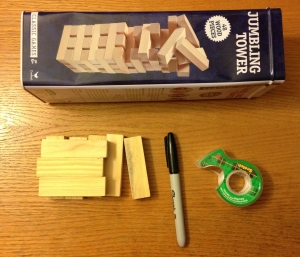Communication Icebreakers for Kids
Communication with your child is crucial. Keeping an open line of communication between you and your child keeps you informed on what is going on in their life, their friendships, and also increases the likelihood that your child will come to you for advice when they have a conflict or are in a dilemma. While this information is helpful, getting children to talk is not always an easy task, especially when a communication disorder is present.
Communication is not always easy, and talking about more serious or intimate topics does not just roll off the tongue. Reaching a more intimate level with your child requires time and practice talking together. Here are a few simple and easy DIY icebreaker activities to open up dialog and start to get children talking. With these communication icebreakers, you can work on getting to know your children better, practice conversation starters, and start building the foundation for a deeper, more intimate relationship.
________________________________________________
Talk Toss
The first icebreaker is called Talk Toss, and is a very simple, and portable activity that could be played virtually anywhere. Here is what you will need:
- 1 ball (of any size)
- 10 strips of paper (more or less is fine)
- writing utensil
- 1 die
- timer/clock
On each strip of paper write down a topic. Make sure to include both light and fun topics, as well as heavier or more intimate topics. This step can also be done with the child, and may make the child more receptive to playing if they have a choice in what some of the topics are. If your child wants to help write down topics, split the pile in half so each person can come up with topics. Another important note is to keep the topics vague. More specific topics can corner the conversation, limiting movement (for example: “Favorite Colors” would be hard to talk about for 6 minutes). After all the topics have been chosen, fold them and put them in a bucket or bowl.
Some examples of possible light topics include:
Favorite movies
School
Music
Hobbies
Sports
Places to visit
Video games
Fashion
Examples of possible heavy/intimate topics include:
School
Achievements/things I’m good at
Conflicts
Things that make me sad
Things that make me happy
Relationships
How the game works:
Each person will take turns picking a topic, and rolling the die. The number on the die will determine how long to set the timer. Once the timer is started, each person will take turns tossing (or rolling when working will younger children or children with gross motor limitations) the ball, but with each toss, the person has to say something about himself or herself that relates to the topic chosen. This turn-taking continues until the timer goes off. Play until all the topics are finished or a certain amount of time is reached. Depending on what number is rolled on the die, 10 topics could result in a 30-60 minute game.
Helpful Hints:
As parents, it is important to channel your own experiences. If the goal is to reach more intimate conversation, you will have to be more vulnerable with your answers as well. For example (with school as the topic), “At school I was really good at math” is not as provoking as, “At school I didn’t have a lot of friends.” With practice this game can invoke more honest and “authentic” answers from your child. However, if they do not reciprocate right away, do not panic. Opening up requires being vulnerable and requires trust – both of which require time. If the child feels pressured or rushed to open up, the opposite of what is desired may occur. A slow and sincere approach will usually yield the best results. An additional benefit to this game is that it is flexible, and can be played almost anywhere. A small bouncy ball, a Ziplock bag, and a cell phone (for a timer) can easily fit in a purse or carry-on bag to be utilized in a waiting room, airport, or in the grocery store.
Grab and Gab
Grab and Gab is another communication icebreaker that can be made for very cheap, and can be played with several players, or just two! Materials needed include:
- Jumbling Tower puzzle game (can be found on Amazon.com for as little as $9)
- Permanent marker
- Tape labels (optional – will allow the blocks to be changed in the future)
Take all of the blocks in the game, and divide them equally into any number of piles (it is okay if they are not exactly equal; Usually 6-8 piles is sufficient). If using tape, apply a strip of tape to one side of each block. For each pile, come up with a starter sentence. You will be writing this sentence on the block (or the tape). Some example starter sentences can be:
If I could be any animal I would be …
I feel happiest when ….
I feel nervous when …
Things that make me happy are…
I often think about …
My favorite quote is …
How the game works:
Once all the starter sentences are written on the blocks (or the tape), the game is played just like the original Jumbling Tower instructions (see the instructions included in the game), only the player has to finish the sentence on the block they choose before they place it back into the puzzle. An alternative version of the game is to have one player pick the block, and the opposite player (or player to the left if playing with more than two people) has to finish the sentence. This alternative method will be helpful if the child starts to memorize which blocks contain certain sentences, and starts to strategically pick or avoid certain blocks.
Helpful Hints:
This game is very similar to the Talk Toss icebreaker. It is important to have a good mixture of light/fun sentences and heavy/intimate sentences, and it is important that the child does not feel forced into starting the game off by saying something they do not feel comfortable sharing. The goal is to make the child feel comfortable, and that comes with time and practice. If the deck is stacked too heavy, you will not get the results you want. Be aware that some questions (for example, “If I could be any animal I would be…”) may lead to more personal or intimate answers than expected. Do not assume that a light sentence answer is irrelevant. An answer of “… a bear because they get to hide away in a cave for 9 months and not talk to anyone,” tells more about a child’s internal emotional state than “… a monkey because they get to eat bananas and I love bananas!” Sometime the answer can have more meaning, and sometimes the answer is just straightforward. It’s important to be listening to the answer, and really trying to understand what the child is telling you. The main goal of the game is to learn how to communicate, and that includes active listening. (For more important information on effective communication and listening, see my previous post ‘Tips for Improved Communication’ here.)
If the starter sentences start to get routine, or you think of new starter sentences you would love to add, you can always change up the sentences. It’s always a great option to include the child in creating starter sentences.
_______________________________________________
These two communication icebreakers are a great way to start practicing dialog between parent and child, and to reach a more intimate level of communication. The icebreaker games can be played for fun, or during more serious moments, and can be played almost anywhere! Remember, the most important part is that the activity is fun, relaxing, and not forced! Oh, and do not forget to listen! If you are not getting the answer you want right away, that’s okay. It takes time and practice! Do not rush the experience, and the results will be rewarding. Stay tuned for more interventions and icebreakers!
______________________________________________________________________________________________
 Vanessa Lemminger M.A., LMFT 53937
Vanessa Lemminger M.A., LMFT 53937
Marital and Family Therapist
© Vanessa Lemminger, M.A. Marriage and Family Therapist 53937, 2014. Unauthorized use and/or duplication of this material without express and written permission from this author and/or owner is strictly prohibited. Excerpts and links may be used, provided that full and clear credit is given to Vanessa Lemminger, Marriage and Family Therapist 53937 with appropriate and specific direction to the original content.
This blog (https://vanessalemminger.wordpress.com/) is for informational and educational purposes only. No therapist-client relationship arises. The information provided and any comments or opinions expressed are intended for general discussion and education only, even when based on a hypothetical. They should not be relied upon for ultimate decision-making in any specific case. There is no substitute for consultation with a qualified mental health specialist, or even a physician, who could best evaluate and advice based on a careful, considered evaluation of all pertinent facts. Likewise, it is understood that no guarantee or warranty arises from the information provided or discussed on this (https://vanessalemminger.wordpress.com/) blog.






 Vanessa Lemminger M.A., LMFT 53937
Vanessa Lemminger M.A., LMFT 53937